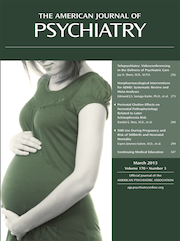Madness at the Theatre
The study of the humanities has been, and should continue to be, integral to the study of psychiatry. The exploration of human strength and weakness, motivation, failure, adaptive and maladaptive responses to adversity, and the essence of what it means to be human in all its folly only works to improve our understanding of our patients. It is what sets psychiatry apart from all other fields of medicine. In this age of the brain and increasing biological understanding of behavior and illness, however, we, as Lipowski warned more than 20 years ago, run the risk of becoming a “mindless” profession (1), which makes the study of the humanities all that more important to the contemporary psychiatrist. Theater, in particular, offers perhaps the best modality for the psychiatrist to reflect on the human experience, as it is an art form that addresses not only the study of human nature but also reflects the society and culture in which it was created. It also is a shared, actual experience between the playwright, the actors, and the audience. This is the subject matter of Femi Oyebode’s Madness at the Theatre.
Oyebode is in a unique position to write about the overlap of the humanities with psychiatry. He is a professor of psychiatry at the University of Birmingham with research interests in descriptive psychopathology and delusional misidentification syndromes, but he is also a poet and literary critic, having written extensively on the relationship between literature and psychiatry. For this reason, I approached his latest slim, yet dense, volume with great anticipation.
Oyebode lays out the thesis of this book in the preface: “a demonstrable progression of method and system exists in the portrayal of mental illness, of madness in the theatre…and has implications for the perception of madness by the lay public and perhaps also for patients and psychiatrists” (p. vii). To this end, Oyebode traces the portrayal of madness in theater from the ancient Greeks and Romans to contemporary times. Each chapter stands alone and offers so much more than is stated in the thesis that this volume becomes a description of the psychological evolution of the playwright’s craft. At its most basic level, the book examines “how” madness is depicted, through language, staging, movement, and costuming. But beyond these basic tools of the playwright’s craft, Oyebode also examines the changing explanation and understanding of madness at these various time points in human history as depicted in the theater. The first five chapters examine expected examples of theater with which most readers would be familiar: Greek tragedy, Greco-Roman comedy, Shakespeare, Ibsen, Tennessee Williams, and Eugene O’Neill. Although these works have already been written about extensively, Oyebode brings a fresh perspective to the understanding of these plays and of the importance of these plays in being reflections of the understanding of mental illness in their respective societies. In the classic Greek tragedies, such as Sophocles’ Oedipus Rex, the violent repercussions of madness are never witnessed by the audience but are described after the fact, while in the Greco-Roman comedies, madness is portrayed directly on stage but as buffoonish folly, with madness becoming “an object of spectacle” (p. 17). Shakespeare showed both the development of madness, particularly through jealousy and envy (experiences common to his audience), as well as the full portrayal of madness on the stage, although he limited his setting to historic courts. The settings for Ibsen’s tragic works were the sitting rooms of his very audience, bringing the experience of tragic madness that much closer to home. Williams and O’Neill continued this evolution by bringing into play autobiographical elements that were fictionalized on the stage and a broader understanding of madness, which included addiction. In his final two chapters, Oyebode turns his attention on two less well-known modern playwrights: Wole Soyinka and Sarah Kane. The African playwright Soyinka explores the effect a society gone “mad” has on the development of madness within an individual. Although Soyinka is not universally familiar to the student of theater, he is a good representation of this theme found in many contemporary theatrical works. The final chapter examines the work of Sarah Kane, a troubled British playwright who ended up taking her own life. Arguably of most interest to psychiatrists, her work focuses on the inner experience of madness, nakedly portraying the psychotic thought process of her own mind. Oyebode argues that her work represents the “logical culmination of the development of how madness has been treated in the theatre” (p. ix). While I found this chapter as consuming and fascinating as the rest of this book, it did seem that Oyebode chose this example more to support his thesis rather than truly show where the portrayal of madness in the theater had evolved, as Kane’s work is clearly not typical of contemporary theater.
My only criticism of this book is that there is too much of interest and import to the reader to be contained within such a small volume. I found myself almost startled when chapters would end, as it often seemed that Oyebode’s observations and commentary were only partially explored. I repeatedly was left wondering about the “why” of this evolution of the portrayal of madness—what existed in the respective societies that allowed these playwrights to advance the representation (and understanding) of madness. This is only addressed in the chapter on Soyinka but seems to be an important omission in the remainder of the text. Reading this work, however, did trigger within me a desire to read more of the source material and more of Oyebode’s important contributions to this literature.
1 : Psychiatry: mindless or brainless, both or neither? Can J Psychiatry 1989; 34:249–254Crossref, Medline, Google Scholar



